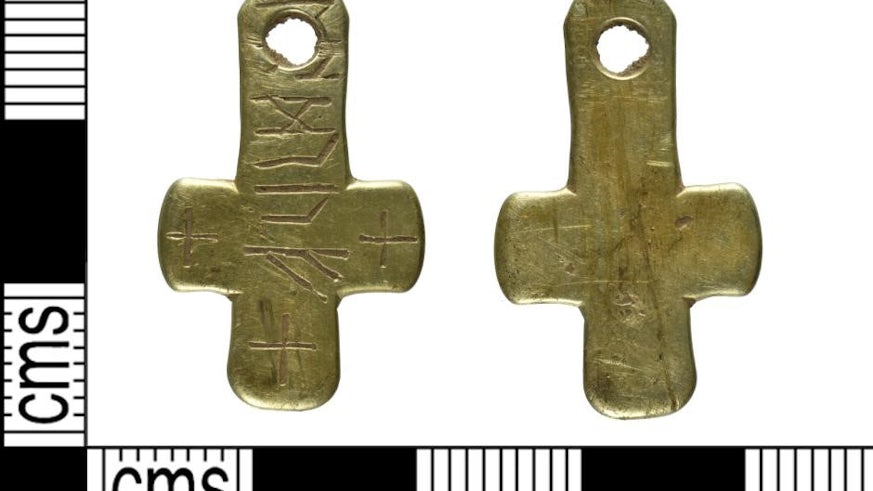Runes and the riddle of the Anglo-Saxon pendant
16 December 2021

Cardiff archaeologist discusses a puzzling Anglo-Saxon name inscribed on 1,000 year-old cross found during pandemic
An Anglo-Saxon pendant found in 2020 on a riverbank in northeast England has provided more surprises for experts of the period, through specialist interpretation of its inscription.
Most early Anglo-Saxon crosses are equal armed, but none have been found before with runic inscriptions.
Dating from between 700 and 900 AD, the solid gold cross pendant discovered in Northumberland also bears runes including “Eadruf” a name never seen before in Anglo-Saxon records.
Runes – characters from an ancient Germanic-based alphabet conveying special meanings - were incised down the length of the arm to just past the crossbar, and three small crosses were also carved in.
The unusual inch-long pendant bears inscriptions on its arms and foot. Experts say it was perforated at the apex, with Anglo-Saxons filing the basic hole after the runes were carved. This additional modification is likely to have been undertaken after the loss of its original top-mounted loop.
The Portable Antiquities Scheme consulted specialists to examine the cross and translate the inscription following reports of the find near Berwick-upon-Tweed by a metal detectorist.
In his report, Professor of Archaeology John Hines explains:
“It seems likely from the width and shape of the cuts that the three incised crosses at the ‘head’ end of the shaft and in either arm were cut at the same time as the runes. Six runes can be identified, reading left to right from the ‘foot’ of the shaft, with the first two drilled through by the wide perforation.
“Artefacts such as this are quite often inscribed with the personal name of a person with whom the object had been associated (usually to be assumed as the possessor, if nothing else is indicated). Old English personal names beginning Ead- (‘happiness’, ‘fortune’) are common, but the only two known with a second element beginning r- are Eadred and Eadric. No personal-name element ruf can be identified in any Germanic language, and Eadruf would therefore be a hitherto unknown and etymologically mysterious name. It could be that this is a slightly cryptic version of a much better known name, Eardwulf; there were some important men with that name in early Northumbria.”
At the time the pendant was made, the Tweedmouth area was part of a group of holdings belonging to the Holy Island of Lindisfarne. While there are records indicating a church or abbey may have been in the vicinity, there is no archaeological evidence of any structure from the early Middle Ages.
To date, the pendant is the earliest Anglo-Saxon object found in the area, predating the only other find - a late 10th century copper-alloy strap fitting.
Professor John Hines is a specialist in the archaeology, literature and languages of medieval northern Europe.